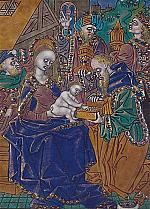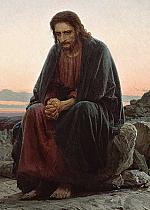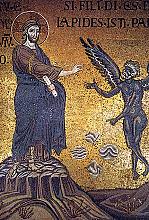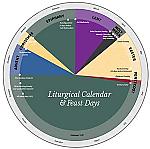Twelve days of Christmas
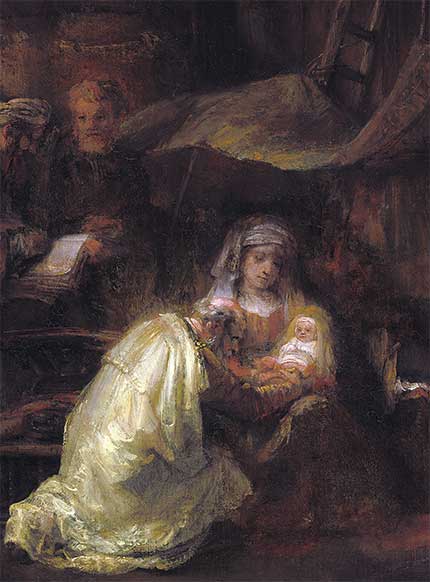
[ABOVE: Detail from Rembrandt van Rijn, The Circumcision, 1661. Oil on canvas—National Gallery of Art, Washington D.C., Widener Collection / Public domain, Wikimedia]
You may be familiar with the song “The Twelve Days of Christmas.” Some people sing it as though these 12 days of Christmas end on Christmas Day. As a matter of fact, though, that’s historically when Christmas celebrations were supposed to start. More than just lending their name to a cryptic holiday song, the “real” 12 days of Christmas give us a way to reflect on what the Incarnation means in our lives.
Where did it come from?
Moving the date of the Nativity celebration backward from January 6 to December 25 while still celebrating Epiphany on January 6 caused an increased emphasis on the period of Christmas celebrations in between. The Council of Tours in 567 officially named this as a special season of feasting and thus asked people to fast during Advent in preparation for the later celebration.
How is the date determined?
Most Christians who observe the 12 days count them as beginning on Christmas Day itself and ending on January 5, or the Eve of Epiphany, also known as Twelfth Night (which is indeed where the title of the Shakespeare play comes from; the play touches on some of the themes of the season).
Theological themes
Of course all the themes that center around Christmas Day are still emphasized during Christmastide—the wonder of the Incarnation and the profound mystery of the Word becoming Flesh (John 1:18). In both East and West, specific feasts that occur during this time have become an important part of the observance of the season.
In the West the main feast days that occur during the 12 days of Christmas are St. Stephen (December 26), St. John the Evangelist (December 27), the Holy Innocents from Matthew 2:16 (December 28), and New Year’s Eve and New Year’s Day. Roman Catholics also observe feast days for St. Thomas Becket (December 29) and the Holy Family (December 30).
You may have heard December 26 described as “Boxing Day” from the custom of boxing up donations for the poor on this day; the most famous seasonal carol about this, of course, is “Good King Wenceslaus,” which features the titular king (actually, a duke of Bohemia) choosing to help a poor peasant on this day. January 1, eight days after the birth of Christ, is observed in various churches as the Solemnity of Mary Mother of God, the Feast of the Circumcision, or the Feast of the Holy Name—all titles relating to the naming and circumcision of Jesus on this day. (The time from December 25 to January 1 is often called the “Octave” of Christmas to emphasize that it lasts eight days. We’ll encounter this term again when we get to the Easter season.)
In the East the Feast of the Nativity is understood to last for three days and to encompass the birth itself on the 25th, a feast dedicated to the role of the Virgin Mary in the Incarnation on the 26th, and St. Stephen on the 27th. The Eastern church remembers the Holy Innocents on December 29. The “afterfeast” of Christmas lasts until December 31; the Feast of the Circumcision is celebrated on January 1 (as is the feast day of St. Basil the Great), and the “forefeast” of Epiphany begins on January 2.
Colors
The same colors used for Christmas Day are used during this time—white and gold in the West and gold in the East.
Customs
Historically some of the merrymaking that caused the suppression of Christmas took place during Christmastide, with various celebrations of the topsy-turvy and the unruly. In medieval Europe, a “Lord of Misrule” was often elected at Christmas and ruled the festivities until Epiphany. A schoolboy, traditionally chosen as bishop on December 6 (the Feast of St. Nicholas), filled all the functions of a bishop until Holy Innocents’ Day. The Christmas season sometimes saw the “Feast of the Ass,” commemorating the donkey traditionally present at the manger, and some people celebrated the “Feast of Fools” on or around January 1.
Today the period is still seen as one of celebration—in liturgical churches, elaborate sanctuary decorations and the singing of Christmas carols and hymns continue. In the East fasting is forbidden during this time until January 5. Many Western churches have some form of a “watchnight” on New Years’ Eve—a service, often multiple hours long, where people gather to pray, repent of the past year’s sins, commit themselves anew to Christ, and take Holy Communion (or a simple meal of bread and water). Among the most famous forms the watchnight has taken historically are the Moravian lovefeasts and the covenant service that John Wesley developed for Methodists thanks to Moravian influence. CH
Some things you can do at home
• Consider continuing to celebrate Christmas traditions that you might previously have limited to Christmas Day: spread out gift-giving, continue lighting the Advent wreath including the Christ candle, leave up Christmas decorations, send out cards, prepare and eat festive foods.
• On Saint Stephen’s Day/Boxing Day, do something to aid those in need.
• If you cannot attend a watchnight service, take stock of your year on December 31 in a personal or family context.
• Learn about all the feast days celebrated during this period. Tell their stories and make traditional foods related to them.
(This section incorporates text from “The Real Twelve Days of Christmas” by Edwin and Jennifer Woodruff Tait in CH #103.)
By Jennifer Woodruff Tait
[Christian History originally published this article in Christian History Issue #156+ in 2025]
Jennifer Woodruff Tait is Senior Editor of CH magazineNext articles
Ash Wednesday
Believers are commanded to observe the beginning of Lent with repentance and prayer.
Jennifer Woodruff TaitForty days in the desert
Lent is a time of preparation for the celebration of Jesus’s Resurrection and the Easter feast.
Jennifer Woodruff TaitSupport us
Christian History Institute (CHI) is a non-profit Pennsylvania corporation founded in 1982. Your donations support the continuation of this ministry
Donate



